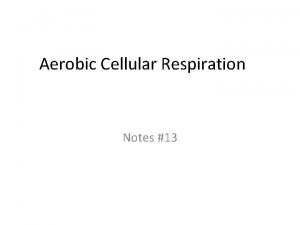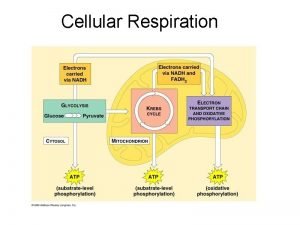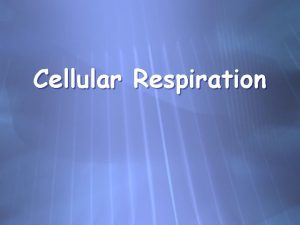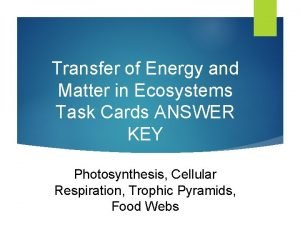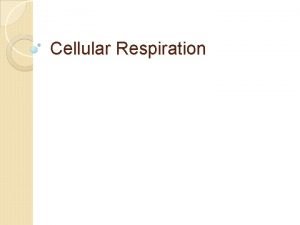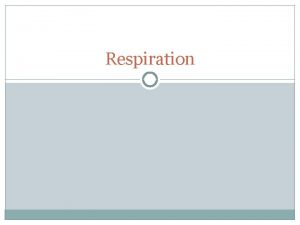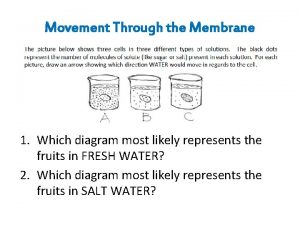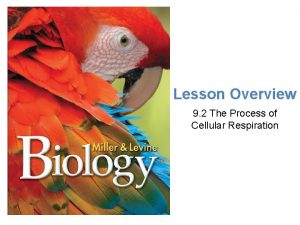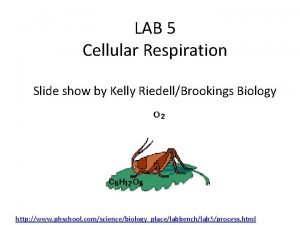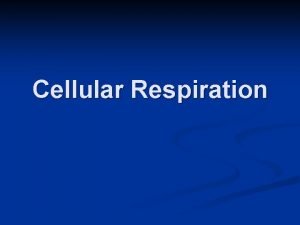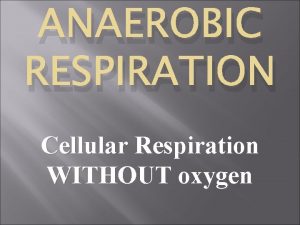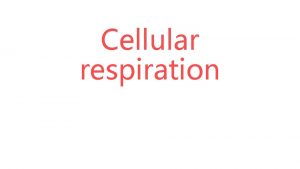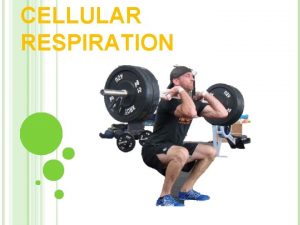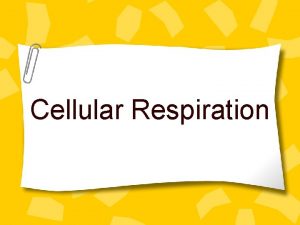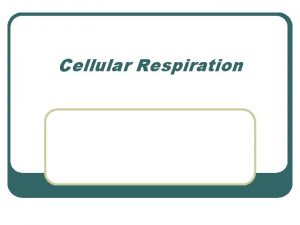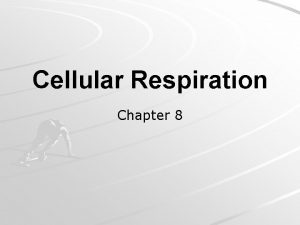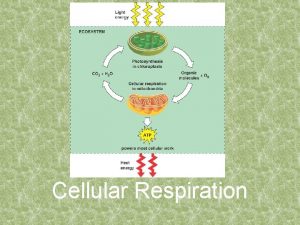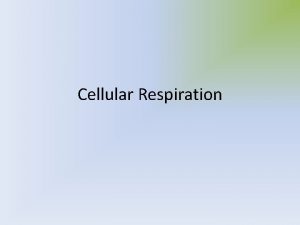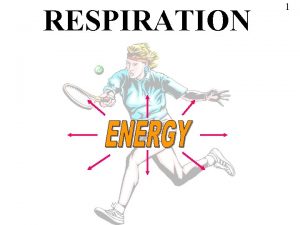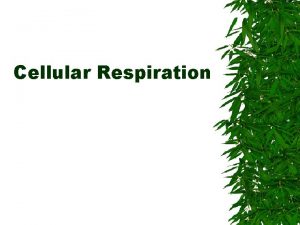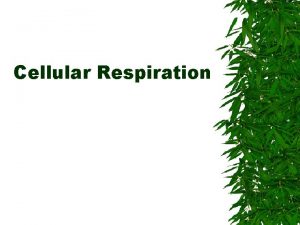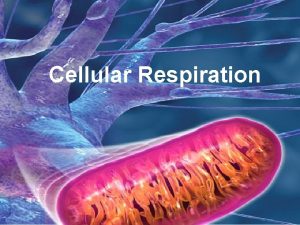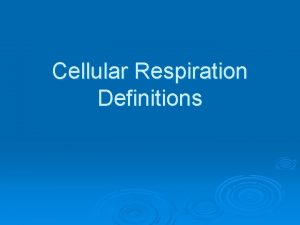CELLULAR RESPIRATION Cellular Respiration What does cellular mean


















![Glycolysis [Stage 1] How Glycolysis Works Glycolysis [Stage 1] How Glycolysis Works](https://slidetodoc.com/presentation_image_h2/e3468b312424e0cdae80dbb6d4988dee/image-19.jpg)
![Krebs Cycle (Citric Acid Cycle) [Stage 2] How the Krebs Cycle works Krebs/Citric Acid Krebs Cycle (Citric Acid Cycle) [Stage 2] How the Krebs Cycle works Krebs/Citric Acid](https://slidetodoc.com/presentation_image_h2/e3468b312424e0cdae80dbb6d4988dee/image-20.jpg)


![Electron Transport [Stage 3] ATP Synthesis Electron Transport [Stage 3] ATP Synthesis](https://slidetodoc.com/presentation_image_h2/e3468b312424e0cdae80dbb6d4988dee/image-23.jpg)




- Slides: 27

CELLULAR RESPIRATION

Cellular Respiration? What does cellular mean? What does respiration mean?

What organisms go through respiration? All eukaryotes (animals, plants, fungi, and protista)

Cellular Respiration: A process that makes ATP by breaking down carbon-based (carbohydrates/ sugars) when oxygen is present. Intro to Cellular Respiration

Cellular Respiration Cellular respiration is the process that converts oxygen and sugar (glucose) into water, carbon dioxide, and energy (ATP).

Respiration Eqn: 6 O 2 + C 6 H 12 O 6 → 6 CO 2 + 6 H 2 O + Energy (ATP) oxygen sugar (glucose) Reactants carbon dioxide water Products energy

The Mitochondrion: “powerhouse” Location of cellular respiration Many exists within a cell Was once believed to be a bacteria that was engulfed by anotherendosymbiosis ATP is made directly from chemical reactions (breaking down food)


Structure of mitochondrion Matrix (fluid inside inner membrane) outer membrane Intermembrane space inner membrane


Cellular Respiration and Fermentation: an anaerobic process that allows glycolysis to continue. does not make ATP but allows glycolysis to continue by providing a supply of NAD+ Anaerobic- does not require oxygen Aerobic-requires oxygen Lactic acid- fermentation in muscle cells (muscle burn) Produces foods like cheese, yogurt, bread, wine)

Demo: Effect of Exercise on Cellular Respiration



Animation of Cellular Respiration

3 Stages: 1. Glycolysis Cell’s cytoplasm 2. Kreb’s Cycle aka Citric Acid Cycle Matrix of the mitochondria 3. Electron Transport Inner membrane of mitochondria

Step 1: Glycolysis Glyco = glucose (sugar) Lysis = split or break up Glucose is split in two

Glycolysis occurs in cytoplasm
![Glycolysis Stage 1 How Glycolysis Works Glycolysis [Stage 1] How Glycolysis Works](https://slidetodoc.com/presentation_image_h2/e3468b312424e0cdae80dbb6d4988dee/image-19.jpg)
Glycolysis [Stage 1] How Glycolysis Works
![Krebs Cycle Citric Acid Cycle Stage 2 How the Krebs Cycle works KrebsCitric Acid Krebs Cycle (Citric Acid Cycle) [Stage 2] How the Krebs Cycle works Krebs/Citric Acid](https://slidetodoc.com/presentation_image_h2/e3468b312424e0cdae80dbb6d4988dee/image-20.jpg)
Krebs Cycle (Citric Acid Cycle) [Stage 2] How the Krebs Cycle works Krebs/Citric Acid Cycle lesson

Step 2: Kreb’s Cycle + Carbon dioxide Makes CO 2 +

![Electron Transport Stage 3 ATP Synthesis Electron Transport [Stage 3] ATP Synthesis](https://slidetodoc.com/presentation_image_h2/e3468b312424e0cdae80dbb6d4988dee/image-23.jpg)
Electron Transport [Stage 3] ATP Synthesis

Step 3: Electron Transport Chain e- force hydrogen ions to diffuse Water is made 36 ATPs (energy) for 1 glucose molecule are made

Step 3: Electron Transport Chain (ETC)


Let’s Wrap it Up- Cellular Respiration story time
 Is oxygen needed as a reactant in the krebs cycle
Is oxygen needed as a reactant in the krebs cycle Krebs cycle occurs in
Krebs cycle occurs in Where does cellular respiration take place
Where does cellular respiration take place Photosynthesis and cellular respiration diagram
Photosynthesis and cellular respiration diagram Where in the cell does cellular respiration occur
Where in the cell does cellular respiration occur Cellular respiration formula
Cellular respiration formula What is mean absolute deviation used for
What is mean absolute deviation used for What does mean mean
What does mean mean Says means matters
Says means matters External respiration vs internal respiration
External respiration vs internal respiration Internal and external respiration
Internal and external respiration Redox reaction in cellular respiration
Redox reaction in cellular respiration What is the correct equation for cellular respiration?
What is the correct equation for cellular respiration? Cellular respiration steps
Cellular respiration steps Cellular respiration product
Cellular respiration product Fermentation definition biology
Fermentation definition biology Why is cellular respiration important
Why is cellular respiration important The process of photosynthesis and cellular respiration
The process of photosynthesis and cellular respiration Chemical formula for cellular respiration
Chemical formula for cellular respiration Cellular respiration reactants
Cellular respiration reactants Formula photosynthesis and cellular respiration
Formula photosynthesis and cellular respiration Photosynthesis recipe card
Photosynthesis recipe card Electron carriers in cellular respiration
Electron carriers in cellular respiration Overview of cellular respiration
Overview of cellular respiration Overview of aerobic respiration
Overview of aerobic respiration Cellular respiration
Cellular respiration Total atp produced in cellular respiration
Total atp produced in cellular respiration Lab bench cellular respiration
Lab bench cellular respiration
